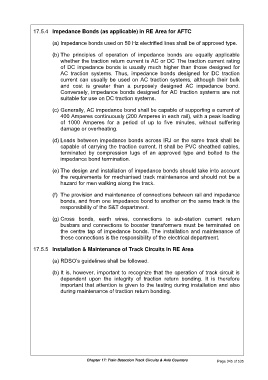Page 397 - IRSEM_Main Book
P. 397
17.5.4 Impedance Bonds (as applicable) in RE Area for AFTC
(a) Impedance bonds used on 50 Hz electrified lines shall be of approved type.
(b) The principles of operation of impedance bonds are equally applicable
whether the traction return current is AC or DC The traction current rating
of DC impedance bonds is usually much higher than those designed for
AC traction systems. Thus, impedance bonds designed for DC traction
current can usually be used on AC traction systems, although their bulk
and cost is greater than a purposely designed AC impedance bond.
Conversely, impedance bonds designed for AC traction systems are not
suitable for use on DC traction systems.
(c) Generally, AC impedance bond shall be capable of supporting a current of
400 Amperes continuously (200 Amperes in each rail), with a peak loading
of 1000 Amperes for a period of up to five minutes, without suffering
damage or overheating.
(d) Leads between impedance bonds across IRJ on the same track shall be
capable of carrying the traction current. It shall be PVC sheathed cables,
terminated by compression lugs of an approved type and bolted to the
impedance bond termination.
(e) The design and installation of impedance bonds should take into account
the requirements for mechanised track maintenance and should not be a
hazard for men walking along the track.
(f) The provision and maintenance of connections between rail and impedance
bonds, and from one impedance bond to another on the same track is the
responsibility of the S&T department.
(g) Cross bonds, earth wires, connections to sub-station current return
busbars and connections to booster transformers must be terminated on
the centre tap of impedance bonds. The installation and maintenance of
these connections is the responsibility of the electrical department.
17.5.5 Installation & Maintenance of Track Circuits in RE Area
(a) RDSO‟s guidelines shall be followed.
(b) It is, however, important to recognize that the operation of track circuit is
dependent upon the integrity of traction return bonding. It is therefore
important that attention is given to the testing during installation and also
during maintenance of traction return bonding.
Chapter 17: Train Detection Track Circuits & Axle Counters Page 345 of 535

